| Pages:
1
2
3 |
Nicodem
Super Moderator
      
Posts: 4230
Registered: 28-12-2004
Member Is Offline
Mood: No Mood
|
|
Quote: Originally posted by Nicodem  | | Under rather extreme conditions it can even be acylated via the Friedel-Crafts reaction (for example with phthaloyl chloride and AlCl3 at 120°C, or
acylation with MeCOCl at 150°C!). |
An example of the Friedel-Crafts benzoylation of 1,4-dichlorobenzene can be found at Synthetic Pages: 2,5-Dichlorobenzophenone (DOI: 10.1039/SP584).
…there is a human touch of the cultist “believer” in every theorist that he must struggle against as being
unworthy of the scientist. Some of the greatest men of science have publicly repudiated a theory which earlier they hotly defended. In this lies their
scientific temper, not in the scientific defense of the theory. - Weston La Barre (Ghost Dance, 1972)
Read the The ScienceMadness Guidelines!
|
|
|
Elemental Phosphorus
Hazard to Others
  
Posts: 185
Registered: 11-11-2016
Location: Is everything
Member Is Offline
Mood: No Mood
|
|
Synthesis of substituted aromatics from paradichlorobenzene
Recently, while going through some old boxes, I found a bunch of old bottles of pesticides. I also found some moth killing crystals that claim to be
pure paradichlorobenzene. They seemed just too good not to use for some chemistry, the crystals are clear and appear to be pure, so I thought I'd have
a go at synthesizing some double substituted aromatics. (I don't know anything beyond very basic organic chemistry). Anyhow, perhaps someone here can
help. I am now unsure what to make (no guaiacol), but can I convert the paradichlorobenzene to a bromo or iodo compound?
Edit: removed mentions of guaiacol synthesis, for obvious (but apparently not obvious enough to me) reasons.
The can  : :
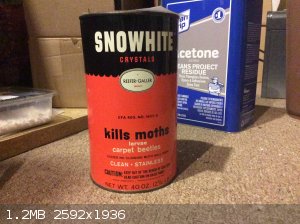 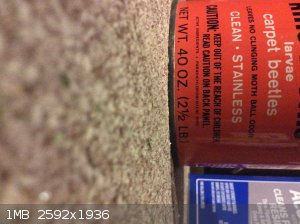
[Edited on 21-10-2017 by Elemental Phosphorus]
|
|
|
Elemental Phosphorus
Hazard to Others
  
Posts: 185
Registered: 11-11-2016
Location: Is everything
Member Is Offline
Mood: No Mood
|
|
Right, I'm a complete idiot. I'll have to settle for something para-substituted then. How could I have made such a lapse as to suggest the synthesis
of an ortho-substituted compound. But perhaps it could be converted to the iodide by treatment with sodium iodide (of any other alkali iodide) in
acetone solution. Anyway I'd honestly have this thread deleted at this point.
Edit: The route with sodium iodide I described will not work. The reaction only works when the organic iodide is insoluble in the reaction solvent,
but the chloride is. Also, it should not work on compounds where the chlorine is on the benzene ring directly and not a side chain.
[Edited on 21-10-2017 by Elemental Phosphorus]
|
|
|
clearly_not_atara
International Hazard
    
Posts: 2787
Registered: 3-11-2013
Member Is Offline
Mood: Big
|
|
:p I think you could substitute the chlorines with something, but because they're chlorines, you'd need a copper catalyst and ligands. If this sounds
like your cup of tea, keep at it, but if making pyridine or 2,2'-bipyridine or 1,10-phenanthroline or maybe ethyl nicotinate all sounds like too much
trouble, then you may not find success.
The first hydrolysis should be pretty fast, so maybe you could make p-chlorophenol or p-chloroanisole?
http://www.orgsyn.org/demo.aspx?prep=cv5p0102
I wonder if Urushibara nickel can be used?
EDIT: No Finkelstein on aryl halides, sorry.
EDIT2: The diol used here:
http://pubs.acs.org/doi/abs/10.1021/jo900438e?journalCode=jo...
can be prepared by the rxn of maleic anhydride with anthracene and reduction with LAH
Someone did it with palladium and sodium methoxide under PTC:
http://onlinelibrary.wiley.com/doi/10.1002/anie.201000576/fu...
I've looked high and low for substitutions of aryl chlorides and the only practical methods go by the intermediacy of organometallic reagents.
EDIT3: Let's follow up on the organometallic for a minute. Anhydrous chromium (II) salts and nickel halide catalyst make aryl Nozaki reagents:
http://en.wikipedia.org/wiki/Nozaki_reaction
These condense with aldehydes or maybe some other moieties of interest...
[Edited on 21-10-2017 by clearly_not_atara]
|
|
|
AvBaeyer
National Hazard
   
Posts: 651
Registered: 25-2-2014
Location: CA
Member Is Offline
Mood: No Mood
|
|
Chemically, p-dichlorobenzene is not useful for very much because of its lack of reactivity. That being said, however, it can be mononitrated which
then renders the chlorine ortho to the nitro group readily displaceable. For example, the chlorine can be displaced by amines, sulfur (eg, mercaptans)
and oxygen (eg alcohols). If you are interested, I can dig up a reference to the nitration which is in an undergrad lab manual that I have stashed
somewhere. You could also do a google search on the nitration of p-dichlorobenzene and find the procedure.
Another use if your sample is pure enough is for molecular weight determination by melting point lowering. This was a pretty standard procedure and a
description of it can be found in older organic qualitative analysis textbooks. Its not used anymore since mass spec is so easily available.
AvB
|
|
|
Nicodem
|
Threads Merged
20-10-2017 at 22:32 |
Elemental Phosphorus
Hazard to Others
  
Posts: 185
Registered: 11-11-2016
Location: Is everything
Member Is Offline
Mood: No Mood
|
|
Actually, I searched for mononitration of paradichlorobenzene, and I didn't find much, so the reference would be appreciated.
Edit: I found a procedure. I am not sure if it is similar to yours, but I can't imagine it is much different, so here it is (from PubChem):
Nitration of 1,4-dichlorobenzene with mixed acid at 35-65 deg C results in a 98% yield of essentially pure 1,4-dichloro-2-nitrobenzene.
Booth G; Ullmann's Encyclopedia of Industrial Chemistry. 7th ed. (1999-2012). New York, NY: John Wiley & Sons; Nitro Compounds, Aromatic. Online
Posting Date: June 15, 2000
[Edited on 21-10-2017 by Elemental Phosphorus]
[Edited on 21-10-2017 by Elemental Phosphorus]
|
|
|
AvBaeyer
National Hazard
   
Posts: 651
Registered: 25-2-2014
Location: CA
Member Is Offline
Mood: No Mood
|
|
For the nitration procedure of p-dichlorobenzene and some reactions of the nitro compound search on Google:
"Fundamental Processes of Dye Chemistry" for a free download.
Examine pages 108ff for the pertinent information. Actually, the entire book is quite interesting and useful.
AvB
|
|
|
Nicodem
Super Moderator
      
Posts: 4230
Registered: 28-12-2004
Member Is Offline
Mood: No Mood
|
|
You must have misspelled something. It took me 1 minute to find the articles for mono- and dinitration using the forum search engine:
mononitration of p-dichlorobenzene
dinitration of p-dichlorobenzene
…there is a human touch of the cultist “believer” in every theorist that he must struggle against as being
unworthy of the scientist. Some of the greatest men of science have publicly repudiated a theory which earlier they hotly defended. In this lies their
scientific temper, not in the scientific defense of the theory. - Weston La Barre (Ghost Dance, 1972)
Read the The ScienceMadness Guidelines!
|
|
|
Elemental Phosphorus
Hazard to Others
  
Posts: 185
Registered: 11-11-2016
Location: Is everything
Member Is Offline
Mood: No Mood
|
|
Alright, so I nitrated 5 grams of paradichlorobenzene in mixed acid at about 50-100 degrees Celsius (I accidentally went a little overboard on the
heating) for about an hour. I got a yellow, water insoluble product. I'll have to weigh it and do some tests on it soon. Anyway, here are some photos
of the reaction.
The starting paradichlorobenzene:
The reaction itself:
The final product:
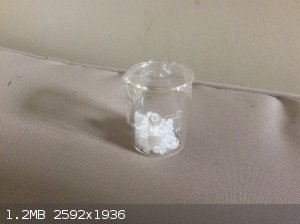 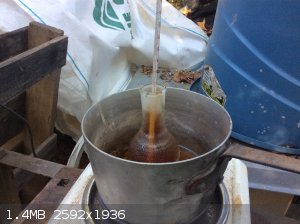 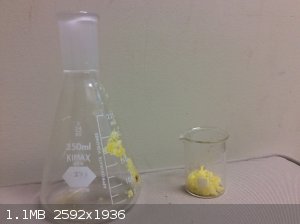
|
|
|
SWIM
National Hazard
   
Posts: 970
Registered: 3-9-2017
Member Is Offline
|
|
Intergalactic_Captain made some of this back in 2005 and reported it to be very irritating to eyes mouth and nose.
He got a little on his hands and it was transferred to his face later inadvertently.
So be careful to wash up and you might want to consider gloves.
I just saw this one report, so it could be erroneous.
It's in the
paradichlorobenzene -> chlorobenzene?
thread
[Edited on 23-10-2017 by SWIM]
|
|
|
Boffis
International Hazard
    
Posts: 1867
Registered: 1-5-2011
Member Is Offline
Mood: No Mood
|
|
Once you have nitrated it (p-DCB) the chlorine in the ortho position to the nitro group should be activated towards substitution as is the case with
2,4 dinitrochlorobenzene, though I suspect its not quite as active but enough to replace the ortho Cl with OH, SH or NH2 groups. The chloro group in
the para position can then be removed by hydrogenation (see US 4207261 Preparation of o-phenylenediamine from p-dichlorobenzene).
It may also be possible to reduce the nitro group to give 2,5-dichloroaniline and then nitrate this further, though the result may be a mixture of
isomers and mono and dinitro substituted compounds. Someone with reaxsys may want to have a look and see if they can find a reference to such a
nitration.
I have done a bit more digging and found a Chinese patent that claims that 2,5-dichloroaniline can be nitrated as its acetylated derivative to give
the 4-nitro aniline that is then reduced to 2,5-dichloro-p-phenylenediamine.
I also found a University of Iowa dissertation on the uses of p-dichlorobenzene from 1919. So most of the reactions are reasonably repeatable for a
well equipped amateur apart from the ones that require oleum but you may be able to get away with alkali nitrate and excess conc sulphuric acid at
higher temperatures.
Elsewhere on this forum I saw a reference to an Org Synth reaction for dechlorinating chlorobenzene to benzene. Has anyone ever tried this with pDCB?
Attachment: Manufacture of 2,5-dichloro-p-phenylenediamine Chinese Patent CN 1974540 B.docx (20kB)
This file has been downloaded 762 times
[Edited on 25-10-2017 by Boffis]
Attachment: A study of paradichlorobenzene IowaUni Dissertation J H Crowell 1919.pdf (4.8MB)
This file has been downloaded 665 times
|
|
|
Elemental Phosphorus
Hazard to Others
  
Posts: 185
Registered: 11-11-2016
Location: Is everything
Member Is Offline
Mood: No Mood
|
|
Yes, I would like to substitute the ortho chlorine with an alcohol. Perhaps someone knows of a procedure? Also in response to SWIM, I do use gloves
when conducting most reactions, so I did not experience any irritation. Unfortunately, I am not set up to hydrogenate, so that's not an option.
|
|
|
Elemental Phosphorus
Hazard to Others
  
Posts: 185
Registered: 11-11-2016
Location: Is everything
Member Is Offline
Mood: No Mood
|
|
Late update, but I found my nitrated paradichlorobenzene product to be soluble in acetone and anhydrous isopropyl alcohol. All of the product was
dissolved in about 30mL of 50/50 isopropyl alcohol-acetone mixture. 5 grams of sodium hydroxide was added, a large excess, and heated with strong
stirring.
The solution's color changed from yellow (like the starting nitrated paradichlorobenzene) to a dark crimson red that was relatively opaque. After
about 15 minutes, the solution was almost boiling. 20mL of water was added, and the solution was brought to a boil. Then, all of the remaining water
and solids were transferred to a large beaker, more water was added, and everything water-soluble was discarded. The remaining solids were broken up,
washed again, and then recrystallized by dissolving them in hot acetone and boiling it off.
This yielded a brown (dark crimson red in solution) solid that did not form large crystals. It was not hard and relatively easy to remove from the
flat bottomed flask in which it was dissolved in acetone and recrystallized. It had a smell like paradichlorobenzene, but mustier.
This was all in an attempt to replace the chlorine next to the nitro group with a hydroxyl group.
I can post pictures of the product, weigh it, test its solubility, etc. if necessary. Was this sufficient to replace the chlorine with an OH group?
Thanks to Nicodem, AvBaeyer, Boffis, clearly_not_atara and SWIM for the suggestions.
[Edited on 1-3-2018 by Elemental Phosphorus]
|
|
|
Boffis
International Hazard
    
Posts: 1867
Registered: 1-5-2011
Member Is Offline
Mood: No Mood
|
|
Well, the first problem I see is the presence of acetone as a solvent in the presence of sodium hydroxide which is likely to cause the acetone to turn
into resinous crap if the reaction mention in my second point below does react with it first.
When some nitrohalobenzenes are heated with alcoholic hydroxide solutions they yield the appropriate halophenyl ether. Unfortunately many are reduced
to azo or azoxybenzene compounds. There is a paper posted on SM that details these compounds and I believe it reducing agent too under these forcing
conditions. As you can see from these comments there is a lot of scope for side reactions. The desired product 4-chloro-2-nitrophenol should be
colourless when pure.
I would suggest trying this reaction with a strong potassium hydroxide solution. Although the nitrohalo compound isn't soluble in KOH the reaction
product is. I am sure I have a reference to the preparation of 2-nitro-4-chloroaniline by fusing the nitrohalo compound with urea.
I'll see if I can find these references.
|
|
|
Elemental Phosphorus
Hazard to Others
  
Posts: 185
Registered: 11-11-2016
Location: Is everything
Member Is Offline
Mood: No Mood
|
|
Yes, there were a lot of problems with my process. Right now I only have fuming nitric acid, and while I could obviously dilute it, will it create a
di-nitro product if I use it directly in mixed acid nitration?
Anders Hoveland posted a graph:
Here is a graph which shows that the paradichlorobenzene is mostly consumed after 15 minutes using 12M (molar concentration) HNO3, at only 10 °C.
http://www.chem.uiuc.edu/weborganic/arenes/Nitration/diClben...
Is it possible that at higher temperatures and using concentrated sulfuric acid as well that some of the di-nitro derivative may have been produced?
I will try again using the method you outline, but would you suggest using KOH in water, or alcohol (which alcohol, I have anhydrous methanol and
isopropanol, but not ethanol) and if so, under reflux, or at room temp, etc. Naturally I would tend to think that reflux would be best, but I don't
know.
(Polverone or woelen, can I have access to references?)
|
|
|
Boffis
International Hazard
    
Posts: 1867
Registered: 1-5-2011
Member Is Offline
Mood: No Mood
|
|
Hi Elemental Phosphorus; I prepared a large amount of the mononitro compound using standard 68% nitric acid some years ago and now have rather a lot
of it. I looked into dinitration and if you have fuming nitric acid this is possible, however, the the process yields a difficult to separate mixture
of of 2,3; 2,5 and 2,6 dinitro compounds. There is a good deal of literature available on this nitration and the subsequent separation. If you are
interested I can dig out and bundle up the papers but some have already been linked to above (Nicodem).
These papers also contain a fair amount of information about preparing the diamino derivatives too.
|
|
|
clearly_not_atara
International Hazard
    
Posts: 2787
Registered: 3-11-2013
Member Is Offline
Mood: Big
|
|
Sulfonation of p-dichlorobenzene occurs in 10% oleum:
https://books.google.com/books?id=eopPAQAAMAAJ&pg=PA152&...
The resulting 2,5-dichlorobenzenesulfonic acid is very strong, comparable to perchloric acid, but much more stable.
|
|
|
wg48temp9
National Hazard
   
Posts: 784
Registered: 30-12-2018
Location: not so United Kingdom
Member Is Offline
|
|
Any progress on getting the chlorines to react without having to nitrate it first and preferable not involving an autoclave?
I am wg48 but not on my usual pc hence the temp handle.
Thank goodness for Fleming and the fungi.
Old codger' lives matters, wear a mask and help save them.
Be aware of demagoguery, keep your frontal lobes fully engaged.
I don't know who invented mRNA vaccines but they should get a fancy medal and I hope they made a shed load of money from it.
|
|
|
Boffis
International Hazard
    
Posts: 1867
Registered: 1-5-2011
Member Is Offline
Mood: No Mood
|
|
@ wg48temp9; I think the simple answer to your question is "no".
What are you interested in or what is your aim? Why not through the nitration route? Mononitration is easy with sodium nitrate and sulphuric acid,
there is no other easy "amateur friendly" route from this compound to anything even sulphonation requires oleum.
I have never found any reference to chlorosulphonation of p-dichlorobenzene with chlorosulphonic acid but this should work too; again not really
amateur friendly.
[Edited on 8-6-2019 by Boffis]
[Edited on 8-6-2019 by Boffis]
|
|
|
wg48temp9
National Hazard
   
Posts: 784
Registered: 30-12-2018
Location: not so United Kingdom
Member Is Offline
|
|
Quote: Originally posted by Boffis  | @ wg48temp9; I think the simple answer to your question is "no".
What are you interested in or what is your aim? Why not through the nitration route? Mononitration is easy with sodium nitrate and sulphuric acid,
there is no other easy "amateur friendly" route from this compound to anything even sulphonation requires oleum.
I have never found any reference to chlorosulphonation of p-dichlorobenzene with chlorosulphonic acid but this should work too; again not really
amateur friendly.
[Edited on 8-6-2019 by Boffis]
[Edited on 8-6-2019 by Boffis] |
My aim was to use a OTC compound that may provide access to interesting reactions and synthesises (or is it synthei). I thought PDB was now not OTC
but I recently found it is still available though it is expensive at £10/100g.
There was also one seller that claimed their old fashioned mothballs was PDB, well perhaps it was old stock.
I am wg48 but not on my usual pc hence the temp handle.
Thank goodness for Fleming and the fungi.
Old codger' lives matters, wear a mask and help save them.
Be aware of demagoguery, keep your frontal lobes fully engaged.
I don't know who invented mRNA vaccines but they should get a fancy medal and I hope they made a shed load of money from it.
|
|
|
XeonTheMGPony
International Hazard
    
Posts: 1640
Registered: 5-1-2016
Member Is Offline
Mood: No Mood
|
|
Nope I have brand new moth balls, in Canada and they where the good ol stuff
|
|
|
clearly_not_atara
International Hazard
    
Posts: 2787
Registered: 3-11-2013
Member Is Offline
Mood: Big
|
|
So I have found on Orgsyn a method where o-nitrophenyl chloride is converted to the bis-aryl disulfide by treatment with sodium sulfide and sulfur in
ethanol with Na2S2 forming in situ:
http://www.orgsyn.org/demo.aspx?prep=cv1p0220
In a 3-l. round-bottomed flask fitted with a reflux condenser are placed 360 g. (1.5 moles) of crystalline sodium sulfide (Note 1) and 1.5 l. of
95 per cent alcohol. The flask is heated on a steam bath until the sulfide dissolves. Then 48 g. (1.5 atoms) of finely ground sulfur is added, and the
heating is continued until the sulfur has dissolved, forming a brownish-red solution of sodium disulfide (Note 2).
This reaction is effective in refluxing ethanol without an autoclave. In our case the reaction should be even faster since the 4-chloro provides
additional activation towards SNAr.
Oxidation of the disulfide with chlorine in aqua regia gives the sulfonyl chloride:
http://www.orgsyn.org/demo.aspx?prep=CV2P0471
This is a fierce choice of rxn conditions of course; I think that this may be done to avoid any reduction of the nitro group by the intermediate
sulfenic and sulfinic acids which would lead to the formation of polymeric side products.
I think that perhaps the use of ozone could be attempted in this case. Of course, it is more dangerous than chlorine... but much easier to generate at
low flow rates.
|
|
|
PirateDocBrown
National Hazard
   
Posts: 570
Registered: 27-11-2016
Location: Minnesota
Member Is Offline
Mood: No Mood
|
|
I'm thinking it would be possible to cajole PDCB to react with sodium alkoxides, provided you have polar, aprotic solvent.
Chlorines will deactivate the pi electrons, sure, but catalytic amounts of silver oxide can push things forward.
From there, you would have an ether, and further substitution would be much easier.
My local Wal-Mart had some PDCB mothballs, maybe I'll play with it some when I have some time.
I'm thinking translithiation might also be possible, allowing a route for reaction with alkyl halides.
[Edited on 6/11/19 by PirateDocBrown]
Phlogiston manufacturer/supplier.
For all your phlogiston needs.
|
|
|
clearly_not_atara
International Hazard
    
Posts: 2787
Registered: 3-11-2013
Member Is Offline
Mood: Big
|
|
https://www.thieme-connect.com/products/ejournals/abstract/1...
We report here the rapid halide exchange in aryl halides facilitated by microwave and conventional heating using nickel(II) halides as reagents.
The methodology can be used for conversion of aryl chlorides to bromides, aryl iodides to bromides and chlorides and aryl bromides to chlorides.
Reactions are fast (5 minutes reaction time for microwave heating and 4 hours for conventional heating) and can be performed without the need for
exclusion of air and water.
NiBr2 in DMF should give (eventually) the dibromide which can then be functionalized by a variety of methods. Unfortunately, since the reaction is
reversible, an excess is most likely required. I do not know how hard it is to obtain anhydrous NiBr2, although the reaction of Ni + CuBr2 seems like
a good guess.
EDIT: it seems that anhydrous NiBr2 (probably needed) could probably be obtained from the decomposition of NiBr2*6NH3, which is easily precipitated
from aqueous solutions of NiBr2:
https://www.sciencemadness.org/whisper/viewthread.php?tid=31...
Of course, the decomposition will give off plenty of smelly ammonia, so be prepared.
Aalten et al (attached) showed that the copper-catalyzed substitution of aryl bromides is largely independent of other substituents, suggesting that
both bromine atoms could be substituted on 1,4-dibromobenzene.
[Edited on 27-8-2023 by clearly_not_atara]
Attachment: aalten1989.pdf (1MB)
This file has been downloaded 187 times
[Edited on 27-8-2023 by clearly_not_atara]
Attachment: leadbeater2003.pdf (63kB)
This file has been downloaded 174 times
|
|
|
clearly_not_atara
International Hazard
    
Posts: 2787
Registered: 3-11-2013
Member Is Offline
Mood: Big
|
|
According to Rao et al, rxn of paradichlorobenzene with NaNH2 in ammonia gives a 2:1 ratio of 4-chloroaniline to 3-chloroaniline.
This allows, among other things, the conversion to mequinol or paradimethoxybenzene, by first oxidizing the aniline group to a nitro group, and then
substituting the chloro with methoxy. Aniline oxidation to nitro has been carried out with e.g. performic acid / PTC:
https://pubs.acs.org/doi/full/10.1021/acsomega.9b00543
among other methods
The resulting 3- and 4-chloro nitrobenzenes will react differently with methoxide: 4-chloronitrobenzene reacts readly with methoxide, while
3-chloronitrobenzene reacts much slower if at all uncatalyzed. This might be a good way to separate the isomers.
4-nitroanisole can then be converted to mequinol by reaction with NaOH (Klan et al, attached) or to paradimethoxybenzene by reaction with NaOMe/MeOH
(van Riel et al, attached).
Attachment: rao2004.pdf (165kB)
This file has been downloaded 82 times
Attachment: klan2002.pdf (107kB)
This file has been downloaded 86 times
Attachment: vanriel1981.pdf (847kB)
This file has been downloaded 87 times
|
|
|
| Pages:
1
2
3 |